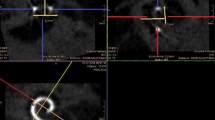Abstract
Purpose
The aims of the present study were to identify detailed positional relationship between the auditory ossicles and to provide theoretic navigational guidelines for optimal prosthesis adaptation and effective malleostapedotomy.
Methods
Fifty sides of the temporal bone from donated cadavers were scanned by MicroCT and the malleus, incus, stapes and tympanic membrane were materialized three dimensionally using computer software. Dimensions between the auditory ossicles closely related to malleostapedotomy were measured twice.
Results
The grip site of malleus handle was mean 1.8 mm superior and mean 1.3 mm anterior, and linear distance between the grip site of malleus handle and the footplate of the stapes was mean 6.5 mm. The stapes was not parallel to the tympanic membrane and rotated mean 10.7° posteriorly relative to the tympanic membrane.
Conclusion
Surgeons should start with at least 8.75 mm prosthesis to cover the upper limits of potential anatomy and then trim down to the individualization to the case. The ideal loop morphology has to be oval shape more than 1.4 mm in the long diameter and 1.0 mm in the short diameter. The wire of the prosthesis has to be bended at the two points: about 10° anteriorly at the most proximal point of the wire and about 50° superiorly at the stapes head point.





Similar content being viewed by others
References
Beger O, Koç T, Karagül M, Özdemir DL, Müdüroğlu F, Cintacioiu DG, Le HT, Vayisoğlu Y, Yılmaz ŞN, Olgunus ZK, Talas D (2019) Evaluation of the stapedial tendon growth dynamic in human fetuses. Surg Radiol Anat 41(7):833–839
Chang MY, Jang JH, Song JJ, Han KH, Lee JH, Oh SH, Chang SO (2012) Malleus neck-anchoring malleostapedotomy: preliminary results. Otol Neurotol 33(9):1477–1481
Fisch U, Acar GO, Huber AM (2001) Malleostapedotomy in revision surgery for otosclerosis. Otol Neurotol 22(6):776–785
Gluth MB, Cohen MA, Friedland PL, Dornhoffer JL, Atlas MD (2012) Malleostapedotomy prosthesis size and shape: key measurements from a temporal bone study. Otol Neurotol 33(4):518–522
Herkenhoff S, Fischer B, Gleich O, Strutz J, Kwok P (2011) A micro-computed tomographic study: determination of the angle between the tympanic membrane and stapes footplate in a total ossicular reconstruction prosthesis reconstruction. Otol Neurotol 32(4):610–615
Iannella G, Angeletti D, Manno A, Pasquariello B, Re M, Magliulo G (2018) Malleostapedotomy in stapes revision surgery: is an endoscopic approach possible? Laryngoscope 128(11):2611–2614
Kwok P, Fisch U, Nussbaumer M, Herkenhoff S, Strutz J (2009) Morphology of the malleus handle and the comparison of different prostheses for malleostapedotomy. Otol Neurotol 30(8):1175–1185
Kwok P, Fisch U, Strutz J, May J (2002) Stapes surgery: how precisely do different prostheses attach to the long process of the incus with different instruments and different surgeons? Otol Neurotol 23(3):289–295
Luers JC, Huttenbrink KB (2016) Surgical anatomy and pathology of the middle ear. J Anat 228(2):338–353
Magliulo G (2013) Self-crimping superelastic nitinol prosthesis and malleostapedotomy: a temporal bone study. Otolaryngol Head Neck Surg 148(2):272–276
Magliulo G, Celebrini A, Cuiuli G, Parrotto D, Re M (2007) Malleostapedotomy in tympanosclerosis patients. J Laryngol Otol 121(12):1148–1150
Mancheño M, Aristegui M, Sañudo JR (2017) Round and oval window anatomic variability: its implication for the vibroplasty technique. Otol Neurotol 38(5):e50–e57
Mason MJ (2013) Of mice, moles and guinea pigs: functional morphology of the middle ear in living mammals. Hear Res 301:4–18
Mukherjee P, Uzun-Coruhlu H, Curthoys IS, Jones AS, Bradshaw AP, Pohl DV (2011) Three-dimensional analysis of the vestibular end organs in relation to the stapes footplate and piston placement. Otol Neurotol 32(3):367–372
Park M, Song JJ, Chang MY, Lee JH, Oh SH, Chang SO (2014) Malleostapedotomy revisited: the advantages of malleus neck-anchoring malleostapedotomy. Otol Neurotol 35(9):1504–1508
Rambousek A, Schlegel CH, Linder TE (2012) From incus bypass to malleostapedotomy: technical improvements and results. J Laryngol Otol 126(10):995–1002
Saha R, Srimani P, Mazumdar A, Mazumdar S (2017) Morphological variations of middle ear ossicles and its clinical implications. J Clin Diagn Res 11(1):Ac01–Ac04
Sevy A, Arriaga M (2018) The stapes prosthesis: past, present, and future. Otolaryngol Clin N Am 51(2):393–404
Singal A, Sahni D, Gupta T, Aggarwal A, Gupta AK (2020) Anatomic variability of oval window as pertaining to stapes surgery. Surg Radiol Anat 42(3):329–335
Standring S (2016) Gray's anatomy: the anatomical basis of clinical practice. Elsevier, Amsterdam
Acknowledgements
This work was supported by the National Research Foundation of Korea (NRF) grant funded by the Korea government (MSIT) (No. 2018R1C1B5045507).
Author information
Authors and Affiliations
Contributions
KJS: project development, data collection, manuscript writing.
Corresponding author
Ethics declarations
Conflict of interest
The authors declare no conflict of interest.
Additional information
Publisher's Note
Springer Nature remains neutral with regard to jurisdictional claims in published maps and institutional affiliations.
Rights and permissions
About this article
Cite this article
Shin, KJ. Navigational guidelines and positional relationships of the human auditory ossicles from three-dimensional topography for ensuring safe and effective malleostapedotomy. Surg Radiol Anat 43, 153–159 (2021). https://doi.org/10.1007/s00276-020-02556-x
Received:
Accepted:
Published:
Issue Date:
DOI: https://doi.org/10.1007/s00276-020-02556-x




